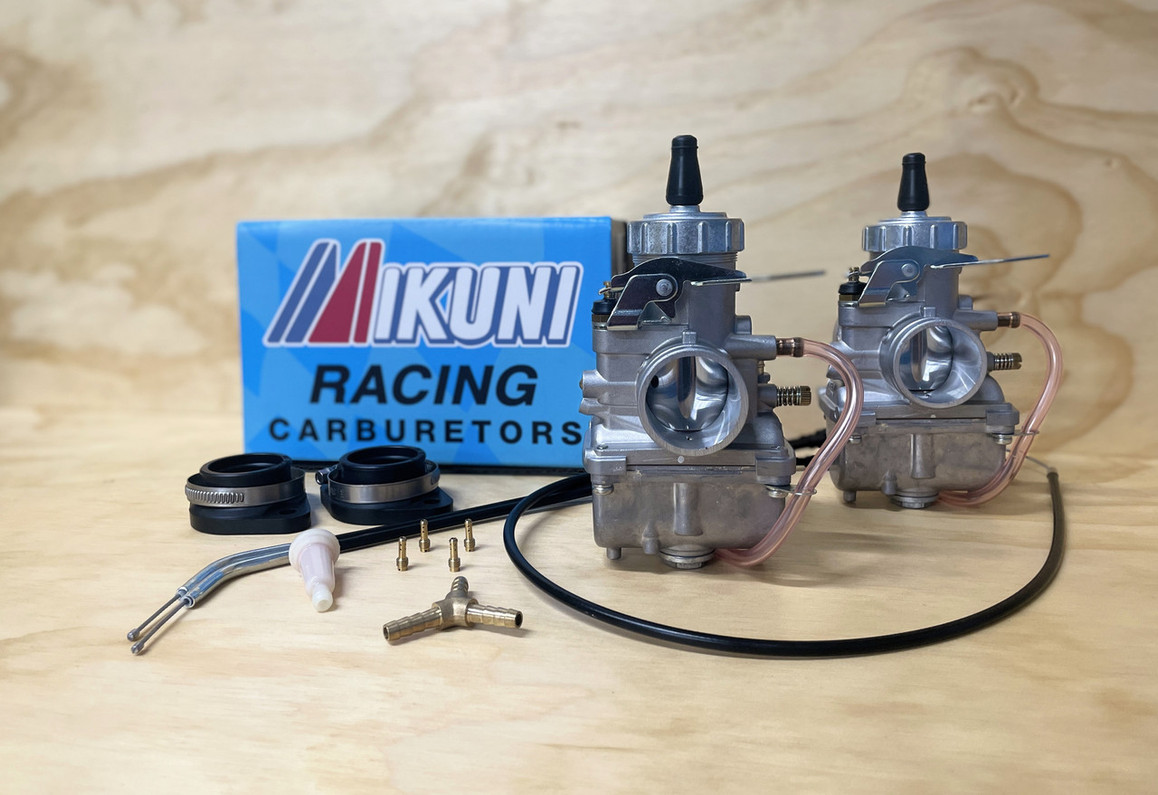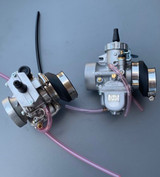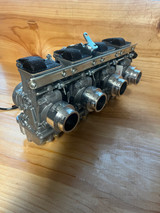How to tune & tips for Mikuni carburetors
Tuning Tips Mikuni Carburetors
Please Note: Other than exact replacement OEM carburetors, all Mikuni Aftermarket Carburetors and Tuning Components are sold “As Is” for Off Road / Racing Use Only and are not intended or approved for use on vehicles operated on Public Roads or in Locations where applicable engine tampering and anti-pollution laws apply.
Mikuni Carburetors should be replaced, repaired or tuned by the selling dealer, or a trained or qualified race mechanic.
SpeedMotoco is not responsible for mechanical damage or personal injury caused by an improperly installed carburetor, operating conditions, its installation and tuning by the vehicle manufacturer, dealer, mechanic or private individual, or their inability to immediately recognize and properly correct unsuitable jetting on any supplied carburetor.
PARTS STAMPING
![]() This marking on a jetting part is your quality assurance guarantee it is a genuine Mikuni component.
This marking on a jetting part is your quality assurance guarantee it is a genuine Mikuni component.
DO NOT ACCEPT SUBSTITUTES.

For tuning procedures we have a number of manuals available to the left. We recommend you down load the HSR tuning books for Harley Davidson. This is perhaps one of the best written book on carb tuning, just ignore the accelerator pump section if using a non pumper carb and remember that the mixture screw is an air screw where as on carbs with the screw located behind the bowl it will be a fuel screw in which case winding out is to make richer not leaner.
By following the procedures in the book you will determine if jets need changing and in what direction.
Order required jets as your checks tell you. Please positively identify your jet type in the jets section, as all jet sales are final with no refunds.
Remember the tuning order is – idle circuit , then main jet and then finally mid range.
If at all in doubt, see your local tuning shop.
Here’s our simple outline for basic tuning to get you started.
1) Idle Circuit:
With your idle circuit, start at 1 1/2 to 2 turns out on the mixture screw and then wind your idle screw back to give a very slow idle whilst at operating engine temp with the bike upright. Follow this with 1/2 turn checks winding in one direction every 10 seconds till the engine starts to stumble, at this point then wind back in the opposite direction counting your half turns till it stumbles again. Wind back ½ the number of counted turns to the centre point. Then count the turns from this point to bottoming out, if you take less than 3 and more than 1 complete turns to achieve bottom, the jet is correct and you simply wind back to the centre point. Job done.
If the jet is wrong, either having no stumble in one direction or the centre point being out of the 1-3 range this will let you know that a jet change is required and weather you need to order richer or leaner jets.
Nothing else other than the pilot jet has an effect at idle. Remember if you don’t wait 10 seconds for the engine to catch up every half turn at a very slow idle this tuning process will not work. Some engines will actually have two size jets that may fall within the 1-3 spec in which case see which feels better when riding, generally the richer one.
2) Main Jet Circuit:
At wide open throttle only the main jet is working so these are also very easy to tune with a few jets and a bit of spare time. The performance changes can be detected at wide open throttle in low gears- we do not recommend the operation of motorcycles over the speed limit.
Change and test with the next size jet both up or down to determine weather an improvement can be obtained and in what direction.
If you notice an improvement in one direction, keep changing to the next jet size in that direction till the improvement stops and she drops off the perch , then go back one. Don’t give up half way through this process thinking you’ve got it right before reaching the limit, otherwise you may will be robbing yourself of a surprising amount of horse power!
Do a plug check to be sure you’re not too lean when finished, job done.
We don’t do returns on jets so maybe buy one bigger and one smaller to determine which way you need to go before then buying a selection in the correct direction (richer of leaner).
Never drill jets and do remember that most aftermarket jets do not flow correctly.
3) Mid-Range
Mark the throttle twist grip and housing with a white out pen to identify when your slide is at ¼, ½, and ¾ opening, this will help you identify any particular problem areas and also keep you operating in the desired testing areas. Generally if you have the right profile needle for your engine, a difference in performance and response can be detected by raising and lowering the needle. If improvements appear in one direction of adjustment but perfection is not achieved whilst having reached the end clip on the needle, then you will need to install a richer or leaner needle if available or else a corresponding needle jet. Once having made a change its back to the middle clip position and start all over again.
An inability to tune out a problem in the mid range will indicate that the needle profile is not matched to your engine or a slide change may be required.
Never change main or pilot jets to try and correct a mid-range problem.
Good luck!
Recent Posts
-
Triump Mikuni Carb Kits!
Wake Up Your Triumph: Why a Mikuni Carb Kit from SpeedMotoCo is the Best Upgrade You’ll Make If …Apr 7th 2025 -
Mikuni HSR EFI conversion kits!
We offer many different types of Harley EFI to carb conversion kits! Ranging from 1100-1700$. Mikuni …Dec 5th 2024 -
Mikuni RS 34, 36, 38 Carburetor Kits NOW AVAILABLE
Looking to spice up or revitalize your old Japanese inline 4 cyl? Look no further! Speedmotoco is no …Nov 13th 2024



